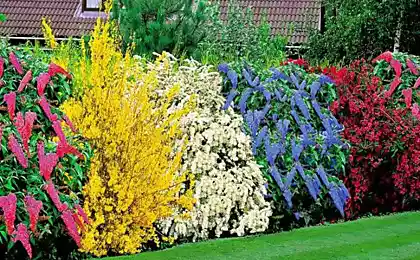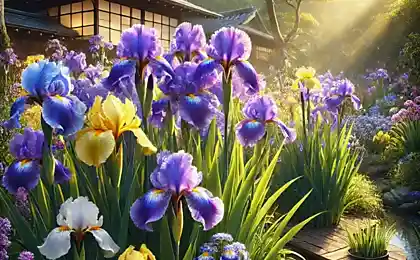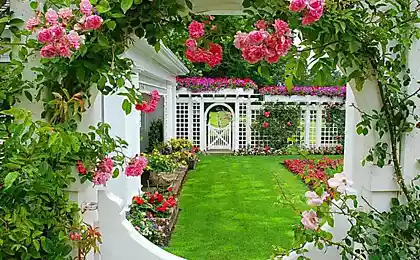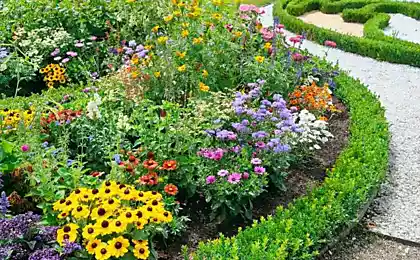504
The purpose – living rainbow in the garden
In the spring, when Bud primroses, and annuals only gain strength, elegant and haughty beauty of the irises is not possible not to notice. If you love these flowers, create on his own exclusive island iris beauty iridary, which will be the highlight of the spring garden, its spectacular and elegant decoration.
A little history... the Word iris is Latin for rainbow. This flower is so named in honor of the goddess of the rainbow iris. Legend has it that when Prometheus gave fire to people, nature was so happy that the sky flashed a rainbow. Her bright beauty could see in the sky all day and all night. And when the morning came, the people saw that the earth was covered with surprisingly beautiful colors, like a rainbow.
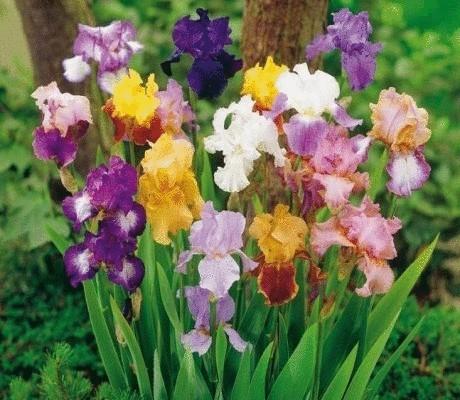
In early may, since 1954, in the Italian city of Florence in Piazzale Michelangelo in the Garden of irises annual festival devoted to this amazing flower that gathers breeders from all over the world.
Iris is a favorite flower of the Florentines. Since 1251, it adorns the coat of arms and flag of the city. In may field in the vicinity of Florence become sky blue from the irises, which from time immemorial cultivated in Tuscany as the most valuable perfume culture.
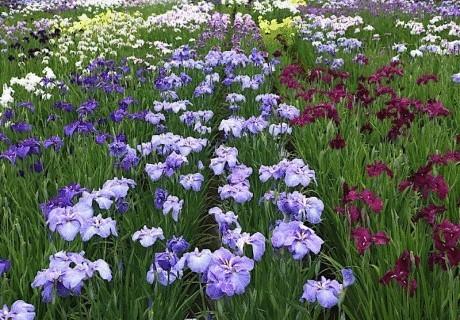
The dried rhizomes of iris have a wonderful scent reminiscent of violets. Of them extract of iris oil, which in perfumes is listed higher than pink.
The family iridaceae Genus iris is so large that to determine the exact number of varieties is virtually impossible.
Iris garden is conventionally divided into 11 classes. They differ from each other in appearance and habitat conditions.

In our territory in a natural environment possible to meet the yellow swamp iris blue Siberian iris, iris Georgian, tonality and the bare.
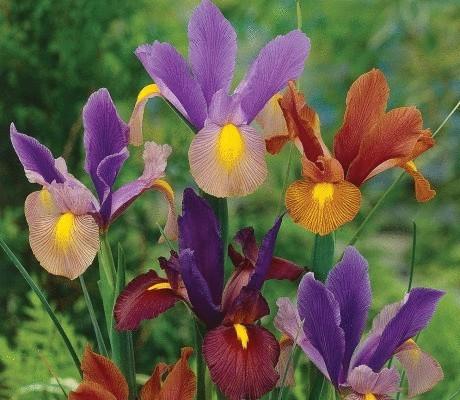
Flower beds are often decorated with bearded irises. They are high-, medium - and undersized, and miniature and dwarf.

Depending on colors they can be divided into: unicolor, bicolor, banded, iridescent.The color palette is rich irises: from pristine white to blue-black.

Siberian iris – beardless, they, despite their elegance, very hardy. Grow in any soil, resistant to winds, but prefer Sunny places.
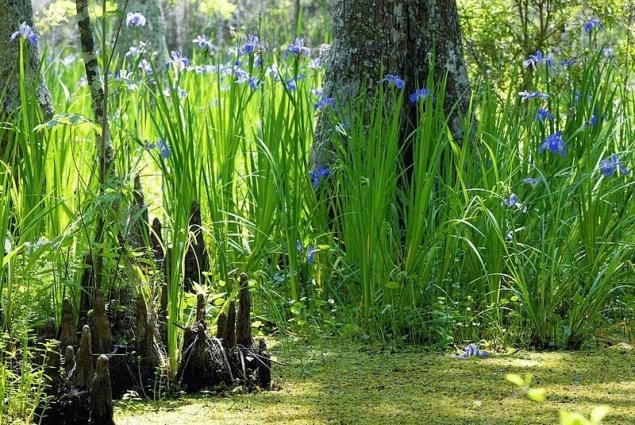
For wet places on the site irreplaceable high marsh irises. Bright lighting to them is not required. However, the farther these irises from moisture, so they are smaller and weaker bloom.
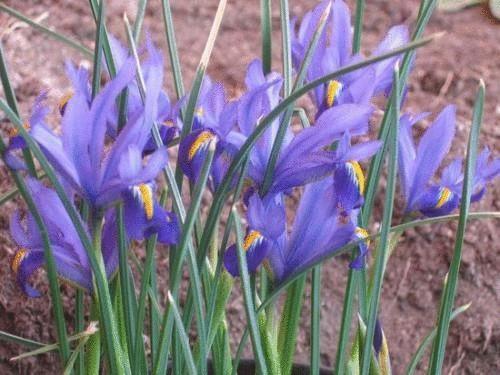
Very interesting look bulbous irises, the flower dimensions are much more modest than rhizomatous. Among them are the real dwarfs and the giants, early-flowering and late blooming.

Spurrier irises – a kind of iris culture, whose colors are similar to the flowers of the bulbous irises. However, they look more respectable. A feature of these irises is obligatory, the penetration of roots into the soil. In one place they can grow up to 10 years.
How to build a purpose cottage Garden irises, similar to other monoidal, - the herb garden or the garden of conifers, devoted exclusively to one flower — Irisa. His unique way of the aristocratic, rich palette of colors and shapes makes the purpose quite unlike the other kinds of gardens. This garden is perfect for the modernist style estate, because iris is a symbol of modernism. It is appropriate and in the style of a Japanese garden.
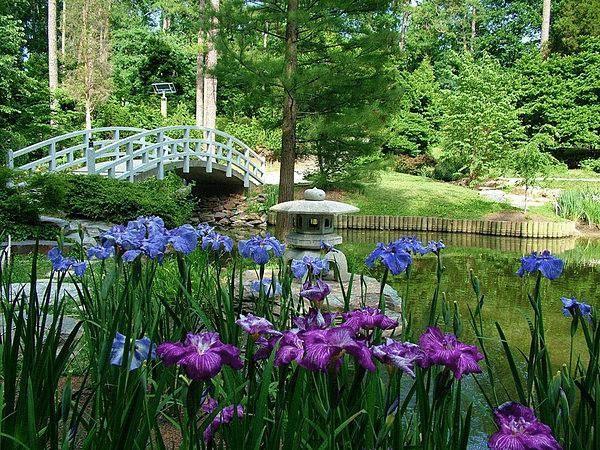
Before starting purpose, first of all, choose the place for it. It is believed that irises – flowers of the morning, the sun first half of the day suits them best. Although these flowers need moisture, but stagnation of water, they can not tolerate. A Sunny position with a slight slope — ideal for decorating purpose. Irises best suited neutral loamy soil, with added sand, compost or peat.

Irises – the flowers are so bright that neighbors find them to be very careful. Background for other purpose may be a screen of conifers or evergreens, as well as the emerald greens of the lawn. Shaping the purpose, you need to consider: what to plant irises in the foreground, which on the second, this must take into account the timing of their flowering.
Closer to the edge it is best to plant dwarf and dwarf varieties in the depths of the flower, the farther from the winds is higher and large. Siberian irises look very good in groups, but the tall bearded – great soloists. If you correctly match the different varieties, you can achieve continuous flowering irises in the next two months.
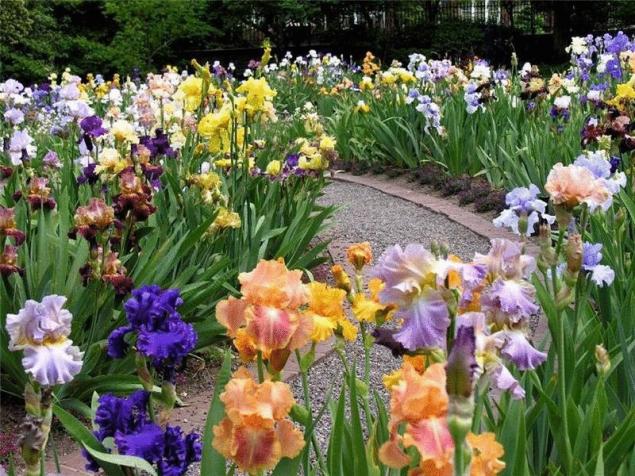
Planting irises, it is necessary to remember that they very quickly grow, forming dense clumps. Therefore, if planting between plants subject to the following distances:
dwarf iris — 10-15cm;
average height – 15-20cm;
tall 35-40cm.
If you wish for the beauty of the flower bed to seal the fit, then once a year to do the thinning, removing excess rhizomes.
Making a collection of irises, planted groups, against the dark colors were planted, and bright – on the contrary, and against the background of plain – pied. Given all the nuances of colors and shapes, play with colours. In the same group do not mix several bicolor varieties irises – their beauty will fade. The result is a featureless blur.
Special attention is paid to the variety of irises, names of which include the word Variegata. This iris with variegated leaves. In all the layouts they are soloists, with flowers and bright leaves, even when the flowering period ends.
Do not worry, if at first you do not get the desired picture. Gradually you will be able to study the characteristics of all varieties and create each ideal conditions.
The purpose on the shore of the pond Considering the fact that irises are moisture-loving plants, and some, for example, marsh irises, thrive in the "knee" in the water, then it would be a sin not to use them to decorate garden ponds.

A little higher, closer to the shore, on the very shallow water, its place will be smooth irises. 6na Bank close to other plants, the composition of the complete Japanese and Siberian irises, also pestrolistye iris Variegata.
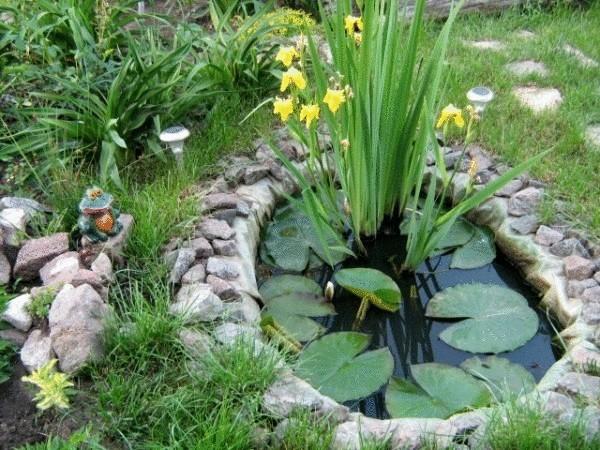
Special care of it is not required, it is necessary only to remove faded flowers and correct growth.
Irises in mixborders to iridary after flowering did not look sad, it is easy to revive other plants. It is possible to add perennials and annuals, only it is necessary to choose such plants, the roots of which are deeper than the roots of the irises.

Get along well with irises Phlox subulate, cerastium, astilba, geyhera, Ajuga, tradescantia virgin, host.
Beautiful structural background create conifer — arborvitae, Hemlock, juniper, dwarf and pyramidal spruce. Also look great with bright irises on a background of a flowering shrub spirea. Irises are planted so that each group of colors contrasted not only with English, but also among themselves.
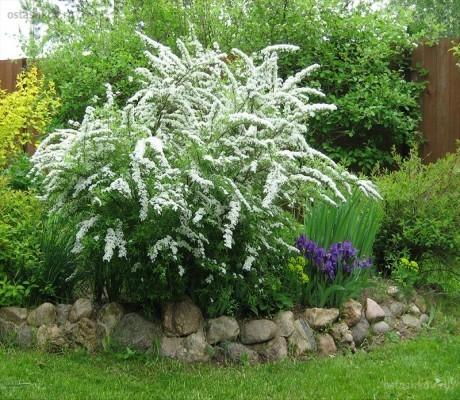
Very interesting combination of dwarf irises with stones and boulders and gravel otsypki. The natural color of the stones is very profitable emphasizes the beauty of irises. Even after flowering irises do not lose their decoration. Therefore, it is appropriate to plant in rockeries and rock gardens.
Be creative and create beauty around them, and one day the goddess Irida will visit your garden and give a good mood.published
P. S. And remember, only by changing their consumption — together we change the world! ©
Source: 101dizain.ru
A little history... the Word iris is Latin for rainbow. This flower is so named in honor of the goddess of the rainbow iris. Legend has it that when Prometheus gave fire to people, nature was so happy that the sky flashed a rainbow. Her bright beauty could see in the sky all day and all night. And when the morning came, the people saw that the earth was covered with surprisingly beautiful colors, like a rainbow.

In early may, since 1954, in the Italian city of Florence in Piazzale Michelangelo in the Garden of irises annual festival devoted to this amazing flower that gathers breeders from all over the world.
Iris is a favorite flower of the Florentines. Since 1251, it adorns the coat of arms and flag of the city. In may field in the vicinity of Florence become sky blue from the irises, which from time immemorial cultivated in Tuscany as the most valuable perfume culture.

The dried rhizomes of iris have a wonderful scent reminiscent of violets. Of them extract of iris oil, which in perfumes is listed higher than pink.
The family iridaceae Genus iris is so large that to determine the exact number of varieties is virtually impossible.
Iris garden is conventionally divided into 11 classes. They differ from each other in appearance and habitat conditions.

In our territory in a natural environment possible to meet the yellow swamp iris blue Siberian iris, iris Georgian, tonality and the bare.

Flower beds are often decorated with bearded irises. They are high-, medium - and undersized, and miniature and dwarf.

Depending on colors they can be divided into: unicolor, bicolor, banded, iridescent.The color palette is rich irises: from pristine white to blue-black.

Siberian iris – beardless, they, despite their elegance, very hardy. Grow in any soil, resistant to winds, but prefer Sunny places.

For wet places on the site irreplaceable high marsh irises. Bright lighting to them is not required. However, the farther these irises from moisture, so they are smaller and weaker bloom.

Very interesting look bulbous irises, the flower dimensions are much more modest than rhizomatous. Among them are the real dwarfs and the giants, early-flowering and late blooming.

Spurrier irises – a kind of iris culture, whose colors are similar to the flowers of the bulbous irises. However, they look more respectable. A feature of these irises is obligatory, the penetration of roots into the soil. In one place they can grow up to 10 years.
How to build a purpose cottage Garden irises, similar to other monoidal, - the herb garden or the garden of conifers, devoted exclusively to one flower — Irisa. His unique way of the aristocratic, rich palette of colors and shapes makes the purpose quite unlike the other kinds of gardens. This garden is perfect for the modernist style estate, because iris is a symbol of modernism. It is appropriate and in the style of a Japanese garden.

Before starting purpose, first of all, choose the place for it. It is believed that irises – flowers of the morning, the sun first half of the day suits them best. Although these flowers need moisture, but stagnation of water, they can not tolerate. A Sunny position with a slight slope — ideal for decorating purpose. Irises best suited neutral loamy soil, with added sand, compost or peat.

Irises – the flowers are so bright that neighbors find them to be very careful. Background for other purpose may be a screen of conifers or evergreens, as well as the emerald greens of the lawn. Shaping the purpose, you need to consider: what to plant irises in the foreground, which on the second, this must take into account the timing of their flowering.
Closer to the edge it is best to plant dwarf and dwarf varieties in the depths of the flower, the farther from the winds is higher and large. Siberian irises look very good in groups, but the tall bearded – great soloists. If you correctly match the different varieties, you can achieve continuous flowering irises in the next two months.

Planting irises, it is necessary to remember that they very quickly grow, forming dense clumps. Therefore, if planting between plants subject to the following distances:
dwarf iris — 10-15cm;
average height – 15-20cm;
tall 35-40cm.
If you wish for the beauty of the flower bed to seal the fit, then once a year to do the thinning, removing excess rhizomes.
Making a collection of irises, planted groups, against the dark colors were planted, and bright – on the contrary, and against the background of plain – pied. Given all the nuances of colors and shapes, play with colours. In the same group do not mix several bicolor varieties irises – their beauty will fade. The result is a featureless blur.
Special attention is paid to the variety of irises, names of which include the word Variegata. This iris with variegated leaves. In all the layouts they are soloists, with flowers and bright leaves, even when the flowering period ends.
Do not worry, if at first you do not get the desired picture. Gradually you will be able to study the characteristics of all varieties and create each ideal conditions.
The purpose on the shore of the pond Considering the fact that irises are moisture-loving plants, and some, for example, marsh irises, thrive in the "knee" in the water, then it would be a sin not to use them to decorate garden ponds.

A little higher, closer to the shore, on the very shallow water, its place will be smooth irises. 6na Bank close to other plants, the composition of the complete Japanese and Siberian irises, also pestrolistye iris Variegata.

Special care of it is not required, it is necessary only to remove faded flowers and correct growth.
Irises in mixborders to iridary after flowering did not look sad, it is easy to revive other plants. It is possible to add perennials and annuals, only it is necessary to choose such plants, the roots of which are deeper than the roots of the irises.

Get along well with irises Phlox subulate, cerastium, astilba, geyhera, Ajuga, tradescantia virgin, host.
Beautiful structural background create conifer — arborvitae, Hemlock, juniper, dwarf and pyramidal spruce. Also look great with bright irises on a background of a flowering shrub spirea. Irises are planted so that each group of colors contrasted not only with English, but also among themselves.

Very interesting combination of dwarf irises with stones and boulders and gravel otsypki. The natural color of the stones is very profitable emphasizes the beauty of irises. Even after flowering irises do not lose their decoration. Therefore, it is appropriate to plant in rockeries and rock gardens.
Be creative and create beauty around them, and one day the goddess Irida will visit your garden and give a good mood.published
P. S. And remember, only by changing their consumption — together we change the world! ©
Source: 101dizain.ru
Anton Khaburskiy about finding opportunities: "We see success stories, but don't know what's behind them"
The recipe from the Soviet Union: balls made of potatoes




